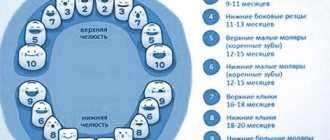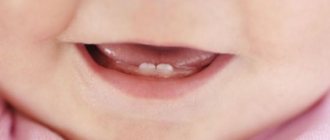All children experience the eruption of their first baby teeth differently. Some kids behave calmly and only act up a little more often than usual. For others, this process does not go so smoothly and is accompanied by constipation, refusal to eat, increased irritability and a rise in temperature.
A particular danger for infants is prolonged retention of stool. It leads to dysfunction of the gastrointestinal tract and intoxication of the body, often causing severe spasms and pain. Find out why constipation occurs during teething in children and what methods can be used to eliminate it.
Timing of teeth appearance. When do teeth start cutting?
Sometimes parents expect that teeth will start cutting in on time, and if this does not happen, they begin to get seriously nervous, because late appearance of teeth can be one of the symptoms of rickets. And the therapist at the appointment can tell you the timing of their appearance for the same reason.
Don’t panic if your child is already 8-9 months old and still has no teeth. In fact, this is only one of many symptoms of such a serious disease that cannot be considered on its own. The process of teething is individual for each child.
The first tooth can appear between 3 and 10 months. And both extreme options are the norm. Only the later appearance of the first tooth can cause some concern in the absence of other external abnormalities.
The average time for teeth to appear can be represented as follows:
- The 2 lower incisors appear first at 6-8 months of age;
- all 4 upper incisors grow sequentially in the period from 8 to 12 months;
- at approximately 10-13 months, the lower lateral incisors appear;
- the first molars, first the upper and then the lower, are cut at 12-15 months;
- fangs appear at 18-20 months, also first the upper ones, then the lower ones.
All 20 teeth finally appear by 2.5-3 years. Moreover, if the baby’s teeth began to cut early, then the process may be completed earlier - already by 2 years. If, on the contrary, the first tooth appeared only at 9-10 months, the last ones can appear only at 3-5 years.
After a year, the baby may cut several teeth at the same time, and then this process can be really very painful.
Teething symptoms
Teething, although a natural process, can cause significant inconvenience. Moreover, the problem, as a rule, does not arise with the first tooth. The lower incisors come out relatively painlessly, but the upper and molars can cause a lot of trouble.
The upper jaw is denser and it is more difficult for teeth to “pierce” it. Molars cause discomfort due to their size.
My son’s first teeth appeared spontaneously, and even the upper incisors erupted quite easily, but then the nightmare began. Almost simultaneously, four teeth began to appear, then two more were added to them, and we learned everything that we had only read about in books before. The child was capricious, refused to eat anything, and could not sleep at night. Only the gum gel saved me, and even then not for long, since it was used strictly according to the instructions in order to avoid complications.
What symptoms can you use to understand that your baby is suffering from teething problems?
- the child becomes capricious;
- in the mouth you can notice redness and, as it were, loosening of the gums at the site of tooth eruption;
- salivation increases;
- the baby may refuse solid food, his taste preferences may change, he may not eat at all;
- a slight increase in temperature may be observed - up to 37.7-38 ° C.
Along with redness at the site of tooth growth, in rare cases, a small hematoma or even an abscess may be observed. They pass with his appearance.
If the inflammation is significant, accompanied by a significant increase in temperature, and the baby’s condition worsens, it is better to take him to the dentist, who will treat the site where the tooth appears to prevent the development of infection.
How to distinguish loose stools from diarrhea
Loose stools are not always a pathology
You can distinguish normal loose stools from pathological ones by several signs:
- Significantly increased number of bowel movements
- Thinner, waterier stool consistency
- Stool comes out in a sudden burst
- The smell becomes more pronounced, sour
- The stool turns green
- Blood, foam or mucus may be found in the stool.
It is important to monitor the general indicators of the baby's condition. Deterioration of appetite and sleep, formation of gas, colic, increased temperature, capricious behavior of the baby are alarming signs.
Myths about teething
Although the appearance of baby teeth can be painful, cause slight inflammation in the mouth and even a slight increase in temperature, it is not a disease.
However, since the antibodies that reach the baby in the mother’s belly are destroyed over time, by six months the baby’s immunity weakens, and the process of teething itself reduces the body’s defenses. This is why other painful conditions may arise during this period, which are very often attributed to the appearance of teeth.
In order not to harm the child, and not to miss the symptoms of another disease during this period, we will dwell in more detail on the main myths about teeth.
Heat
As already mentioned, teething can cause minor inflammation and, consequently, an increase in temperature. But if the temperature is above 38.5° C, especially if it rises to 39° C, it is most likely a cold or infection. And this is a reason to see a doctor.
Loose stools
This myth is especially tenacious among the people. It is believed that teething can have a negative impact on bowel function. Your baby's bowel movements may indeed change if he refuses his usual food because of gum pain, but these are usually minor changes. In very rare cases, loose stools may occur due to increased salivation for no more than 72 hours, and at intervals no more than 3-5 times a day.
If your baby suffers from diarrhea, especially accompanied by vomiting, he probably has an infection. This is not surprising, given how many objects (and not always clean ones) are put into the mouth to relieve itching in the gums.
Runny nose
Indeed, sometimes teething is accompanied by a slight runny nose. But nasal discharge should be thin and clear. If their color is yellowish, greenish, they are thick, and the baby’s nose “can’t breathe” - it’s time to see a doctor.
Cough
Saliva can also get into the baby's throat, causing coughing and wheezing during sleep. But, as a rule, such phenomena are episodic, and the cough cannot be “chest.” If your baby does experience increased salivation, which can make breathing difficult and cause discomfort during sleep, it is advisable to slightly raise the head of the crib. If the cough does not go away in this case, and is observed constantly while you are awake, you should not attribute the problem to your teeth.
Vomit
Increased salivation can provoke a response from the child's stomach, but this happens very rarely, and such a phenomenon is a one-time occurrence. If a child vomits more than once, the teeth have nothing to do with it.
Skin rashes
Teeth cannot in any way affect the condition of the skin. The only thing that can happen is a slight irritation in the child’s mouth from the teether or irritation from saliva. Any other manifestations are a reason to contact a dermatologist.
Otitis
Surprisingly, some believe that teething can cause a disease such as otitis media. Your baby may indeed pull and rub his ears when he is teething, but this is not associated with inflammation. It’s just that the teeth and ears have one nerve center. In this case, there is no reason to give the child medicine or drops.
Other symptoms of inflammation, such as high fever, discharge from the ears, and pain when pressing above the earlobe, may cause concern. Such signs have nothing to do with the appearance of teeth.
What is the type of stool in formula-fed children?
In bottle-fed babies, the feces are the same yellow and mushy-like as in babies raised on breast milk. But feeding with mixtures can provoke the appearance of darker and thicker stools. This is considered the norm. The color of the stool may vary, depending on the composition of the mixture, from pale yellow to brown.
Since more time is spent on digesting the artificial mixture, the number of bowel movements is reduced by approximately half. The volume of stool is larger. It is quite acceptable for artificial patients to retain stool for up to 2 days. If the baby is calm and has no gas, then the parents have no particular reason to worry.
Brushing our first teeth
Some parents believe that oral hygiene should be started when the baby already has several teeth; until then, there is simply nothing to brush. In fact, there are plaques on the child’s gums. These are small films that can accumulate food debris and be a source of infection. For this reason, dentists recommend starting to brush your teeth before they even appear.
It is not recommended to use a full-fledged toothbrush until the age of two. Oral hygiene can be carried out with a special children's brush, which is placed on your finger, or simply with a small piece of gauze soaked in boiled water.
The child’s mouth needs to be cleaned 1-2 times a day, and after the first teeth appear, special attention should be given to them to prevent the development of caries in the future.
How to make teething easier
As already mentioned, a special cooling gel and, of course, the main assistant for parents - a teether, can help the baby with teething. There are currently many of the latter, and by the time teeth appear, it is highly advisable to stock up on not one, but several such toys.
The child will most likely choose the teether that he likes.
- Silicone massagers are softer. If you cool them in the refrigerator before using, you can achieve a cooling effect.
- Rubber massagers are stiffer, stimulate the gums better and, as a rule, have less relief.
A child with different teeth may prefer different types of teethers. For example, my son actively used silicone with his upper incisors, and regular rubber with his fangs.
Traditional methods to facilitate the teething process
In addition to special devices that are sold in pharmacies, you can help your baby with “folk” remedies:
- Give a crust of bread to chew if your baby is already eating solid food. The son was gnawing on his favorite treat - children's cookies. The pleasant taste and slight stimulation of the gums helped relieve his condition for a while.
- If the process is very painful for the baby, and the teether seems unattractive to him, you can let him suck your finger and give him a light massage.
- You can wipe your gums with a chamomile solution - it will relieve inflammation and promote the healing of small wounds. I brewed chamomile and left it in the refrigerator for a few minutes, then wiped my son’s gums with a gauze swab dipped in the cool infusion.
- Decoctions of burdock, sage and plantain roots relieve inflammation, which can also be used to lubricate the gums during a massage.
- Honey will help relieve irritation if the baby is not allergic to bee products. You can wipe your gums, or let them suck on a piece of gauze wrapped around your finger and previously soaked in diluted honey.
- You can brew soothing tea with lemon balm, mint, and valerian. The main thing is that the baby is not allergic to such herbs, and their concentration is small. Mothers can also drink this tea if the baby is breastfed and does not refuse the breast. This measure will make the baby calmer and make it easier to fall asleep.
Don't forget about the beneficial effects of cold. If your baby already eats fruits and vegetables, you can chill the pieces in the refrigerator and give them to your baby.
And remember that the main thing for a child during the teething period is the affection and care of the mother. Feeling your support and love, the baby will be less capricious and will go through this stage of growing up more easily.
Medications
Can medications be used to relieve constipation in children? Prescription of medications is possible only by a specialist (pediatrician) after examining the child. In some cases, additional diagnostic measures are required.
In most cases, the doctor prescribes the following medications:
- Microlax. The active substance is placed in a special bottle with a soft tip, which must be carefully inserted into the rectum according to the instructions. It acts quickly on the principle of cleansing with an enema.
- Rectal suppositories with glycerin or sea buckthorn oil. These products are made on the basis of natural substances that gently soften stool, provoking bowel movements in about a quarter of an hour.
- "Duphalac" based on lactulose.
- "Prelax" in the form of syrup stimulates peristalsis and normalizes intestinal microflora. Consume before meals.
It should be remembered that the use of such laxatives is possible only in emergency cases. If you do this too often, the child’s body gets used to such “help”, after which difficulties arise with normal bowel movements.









